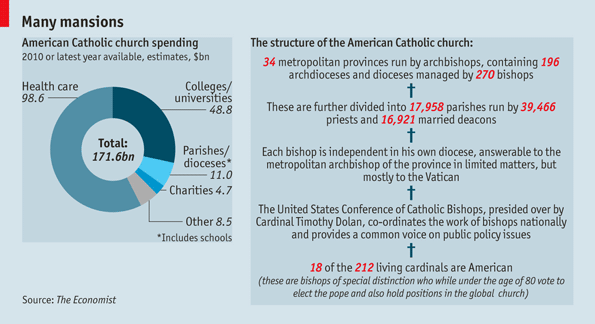The Economist Estimates the Catholic Church Spent $171,600,000,000 in 2010
By Hemant Mehta
The Economist estimates that annual spending by the church and entities owned by the church was around $170 billion in 2010 (the church does not release such figures). We think 57% of this goes on health-care networks, followed by 28% on colleges, with parish and diocesan day-to-day operations accounting for just 6% and national charitable activities just 2.7% (see chart). In total, Catholic institutions employ over 1m people, reckons Fred Gluck, a former McKinsey managing partner and co-founder of the National Leadership Roundtable on Church Management, a lay organisation seeking to improve the way the church is run. For purposes of secular comparison, in 2010 General Electric’s revenue was $150 billion and Walmart employed roughly 2m people. Wow. You knew the Church had money… but that much?! Where does it all come from? Offering plates, donations, tuition money, Medicare/Medicaid payments, and other investments. I thought that the sexual abuse scandal payouts would at least put a dent in their budget. Turns out it’s only a small fraction of it and most of the payments are made by local dioceses and not the Vatican: The molestation and rape of children by priests in America has resulted in more than $3.3 billion of settlements over the past 15 years, $1.3 billion of that in California. The total is likely to increase as more states follow California and Delaware in relaxing the statute of limitations on these crimes, most of which were reported long after they happened. For an organisation with revenues of $170 billion that might seem manageable. But settlements are made by individual dioceses and religious orders, whose pockets are less deep than those of the church as a whole. One of the consequences of the dioceses paying these costs is that some of them have gone out of business and more will likely follow: Over the past eight years, a combination of these stresses has driven eight dioceses (including San Diego, Tucson and Milwaukee) to declare bankruptcy, as well as the American arm of the Irish Christian Brothers and a regional branch of the Jesuits. More of America’s 196 dioceses could be forced to do the same. Efforts are under way in the legislatures of Arizona, Illinois, New York, Florida, Wisconsin, Minnesota, Colorado, Pennsylvania, Ohio and California (again) to extend statutes of limitations, according to Jeff Anderson, a lawyer who represents many victims of abuse. If any of these efforts succeeds, the expectation among lawyers like Mr Anderson is that some of the affected dioceses would seek Chapter 11 protection while they attempt to settle the cases. (Troubled dioceses generally settle suits just before the bishop is due in court.) The diocese of Honolulu could be the next to go bankrupt. In May it was hit by a pair of new lawsuits after the extension of Hawaii’s statute of limitations for victims of abuse. The article also notes that there isn’t a long line of future priests, donations are dropping, and pensions are underfunded. All of that means the future doesn’t look very good for the Church.
|
.
Any original material on these pages is copyright © BishopAccountability.org 2004. Reproduce freely with attribution.
